|
|

This chapter describes how to install your Catalyst 2900 XL switch and interpret the power-on self-test (POST) that ensures proper operation. Read the topics and perform these procedures in the order that they are presented:
 |
Note See the Catalyst 2900 Series XL Modules Installation Guide and the Catalyst 2900 Series XL ATM Modules Installation and Configuration Guide for global information about the Catalyst 2900 series XL expansion modules. |
These warnings are translated into several languages in "Translated Safety Warnings."
 |
Warning Only trained and qualified personnel should be allowed to install or replace this equipment. |
 |
Warning Read the installation instructions before you connect the system to its power source. |
 |
Warning Before working on equipment that is connected to power lines, remove jewelry (including rings, necklaces, and watches). Metal objects will heat up when connected to power and ground and can cause serious burns or weld the metal object to the terminals. |
 |
Warning Do not stack the chassis on any other equipment. If the chassis falls, it can cause severe bodily injury and equipment damage. |
 |
Warning The plug-socket combination must be accessible at all times because it serves as the main disconnecting device. |
 |
Warning To prevent the switch from overheating, do not operate it in an area that exceeds the maximum recommended ambient temperature of 113\xb0 F (45\xb0 C). To prevent airflow restriction, allow at least 3 inches (7.6 cm) of clearance around the ventilation openings. |
 |
Warning The device is designed to work with TN power systems. |
 |
Warning When installing the unit, the ground connection must always be made first and disconnected last. |
 |
Warning This product relies on the building's installation for short-circuit (overcurrent) protection. Ensure that a fuse or circuit breaker no larger than 120 VAC, 15A U.S. (240 VAC, 10A international) is used on the phase conductors (all current-carrying conductors). |
 |
Warning This equipment is intended to be grounded. Ensure that the host is connected to earth ground during normal use. |
 |
Warning Care must be given to connecting units to the supply circuit so that wiring is not overloaded. |
 |
Warning A voltage mismatch can cause equipment damage and may pose a fire hazard. If the voltage indicated on the label is different from the power outlet voltage, do not connect the chassis to that receptacle. |
 |
Warning Do not touch the power supply when the power cord is connected. For systems with a power switch, line voltages are present within the power supply even when the power switch is off and the power cord is connected. For systems without a power switch, line voltages are present within the power supply when the power cord is connected. |
 |
Warning Do not work on the system or connect or disconnect cables during periods of lightning activity. |
 |
Warning Ultimate disposal of this product should be handled according to all national laws and regulations. |
 |
Warning Invisible laser radiation may be emitted from the aperture ports of the 100BASE-FX single-mode supervisor engine module. Avoid exposure and do not stare into open apertures. |
 |
Warning Avoid exposure to the laser beam. |
 |
Warning Attach only the Cisco RPS (model PWR600-AC-RPS) to the RPS receptacle. |
 |
Warning Attach only the Cisco RPS (model PWR300-AC-RPS-N1) to the RPS receptacle. |
U.S. regulatory information for this product is in the front matter of this manual.

This equipment is a class A product and should be used and installed properly according to the Hungarian EMC Class A requirements (MSZEN55022). Class A equipment is designed for typical commercial establishments for which special conditions of installation and protection distance are used.
Figyelmeztetés a felhasználói kézikönyv számára:
Ez a berendezés "A" osztályú termék, felhasználására és üzembe helyezésére a magyar EMC "A" osztályú követelményeknek (MSZ EN 55022) megfeleloen kerülhet sor, illetve ezen "A" osztályú berendezések csak megfelelo kereskedelmi forrásból származhatnak, amelyek biztosítják a megfelelo speciális üzembe helyezési körülményeket és biztonságos üzemelési távolságok alkalmazását.
The switch can be installed on a table or shelf, in a rack, or on a wall.
Before installing the switch, first verify that the switch is operational by powering it on and running POST. Follow the procedures in the "Powering On the Switch and Running POST" section.
 |
Caution There are no serviceable parts inside the unit. Removing screws, cover, or otherwise dismantling the unit voids the warranty. |
 |
Warning Unplug the power cord before you work on a system that does not have an on/off switch. |
When determining where to place the switch, be sure to observe these guidelines:
 |
Note If the switch is installed in a closed or multirack assembly, the temperature around it might be greater than normal room temperature. |
 |
Note The cable guide is not applicable for the Catalyst 2912 LRE XL and 2924 LRE XL switches. |
Follow these steps to install the switch on a table or shelf:
Step 2 Place the switch on the table or shelf near an AC power source.
Step 3 After the switch is mounted on the table or shelf, power the switch as described in "Powering On the Switch and Running POST" section.
 |
Warning To prevent bodily injury when mounting or servicing this unit in a rack, you must take special precautions to ensure that the system remains stable. The following guidelines are provided to ensure your safety: |
The supplied rack-mounting brackets can be attached to a 19-, 23-, or 24-inch rack. Figure 2-1 shows which mounting holes to use.
 |
Note Figure 2-1 shows brackets for two-rack-unit modular switches. Rack-mount points are similar on brackets for one-rack-unit switches. |
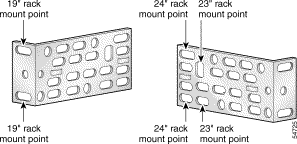
To install the switch in a 19-, 23- or 24-inch standard rack, follow the instructions described in these procedures:
If you plan to install the switch in a rack, you must first remove screws in the switch chassis so that mounting brackets can be attached. Figure 2-3 shows how to remove the chassis screws in a fixed-port and a modular port switch.
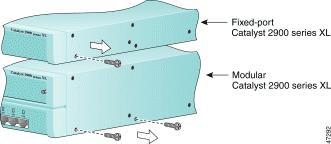
Follow these steps to attach the brackets to a Catalyst 2912 XL, 2924C XL, 2924 XL, 2912MF XL, or 2924M XL switch:
Figure 2-3, Figure 2-5, Figure 2-6, Figure 2-7, and Figure 2-8 show how to attach a bracket to one side of the switch. Follow the same steps to attach the second bracket to the opposite side of the switch.
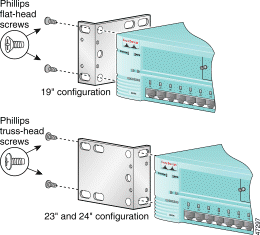

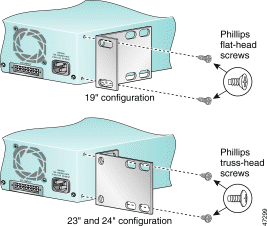
 |
Note Catalyst 2912 LRE XL and 2924 LRE XL switches cannot be mounted in telco racks. |
Follow these steps to attach the brackets to a Catalyst 2912 LRE XL or 2924 LRE XL switch:
Figure 2-3, Figure 2-5, Figure 2-6, Figure 2-7, and Figure 2-8 show how to attach a bracket to one side of the switch. Follow the same steps to attach the second bracket to the opposite side of the switch.

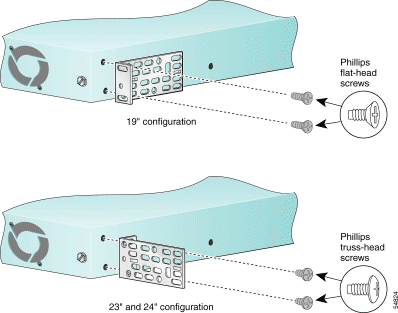
After the brackets are attached to the switch, use the four supplied number-12 Phillips machine screws to securely attach the brackets to the rack, as shown in Figure 2-11.
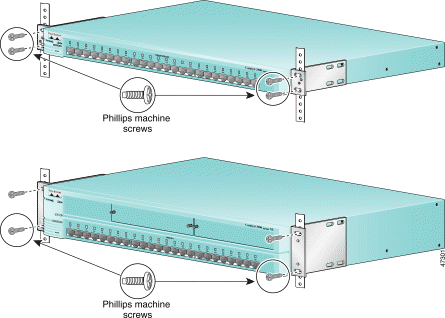
After the switch is mounted in the rack, power the switch as described in "Powering On the Switch and Running POST" section.
We recommend attaching the cable guide to prevent the cables from obscuring the front panel of the switch and the other devices installed in the rack. If the switch is in a 19-, 23-, or 24-inch rack, use the supplied black screw as shown in Figure 2-12 to attach the cable guide to the left or right bracket. The cable guide for the modular switches requires two screws.
 |
Note The cable guide is not applicable for the Catalyst 2912 LRE XL and 2924 LRE XL switches. |
To attach the switch to a wall, follow the procedures in this section:
 |
Note To mount a Catalyst 2912 LRE XL or 2924 LRE XL switch on a wall, you need to obtain two special wall-mount brackets (Cisco part number wallmount-1ru=). To order these brackets, contact your Cisco sales representative. |
The bracket orientation and the screws you use depend on whether you are attaching the brackets for parallel or vertical wall-mounting. Use two of the supplied screws to attach each bracket, according to the following guidelines:
 |
Note The Catalyst 2912 LRE XL and 2924 LRE XL switches cannot be mounted vertically on a wall. |
Figure 2-13 and Figure 2-13 show how to attach the brackets to one side of the switch. Follow the same steps to attach the second bracket to the opposite side of the switch.


For best support of the switch and cables, make sure the switch is attached securely to a wall stud or to a firmly attached plywood mounting backboard, as shown in Figure 2-15, Figure 2-16, and Figure 2-17.
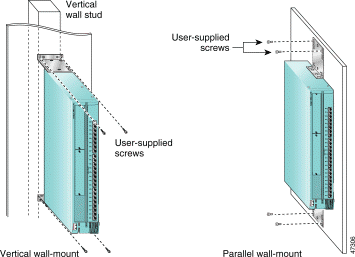
After the switch is mounted on the wall, power the switch as described in "Powering On the Switch and Running POST" section.
To power on the switch after you install it, follow these steps:
Step 2 Connect the other end of the power cord to an AC power outlet.
As the switch powers on, it begins POST, a series of eight tests that run automatically to ensure that the switch functions properly. When the switch begins POST, the port LEDs turn amber for 2 seconds, and then they turn green. The System LED flashes green, and the RPS LED turns off. As each test runs, the port LEDs, starting with number 1, turn off. The port LEDs for ports 2 to 8 each turn off in turn as the system completes a test.
When POST completes successfully, the port LEDs return to the status mode display, indicating that the switch is operational. If a test fails, the port LED associated with the test turns amber, and the system LED turns amber. If POST fails, refer to "Troubleshooting," to determine a course of action.
POST failures are usually fatal. Call Cisco Systems immediately if your switch does not pass POST.
Connecting devices that do not autonegotiate or that have their speed and duplex parameters manually set can reduce performance or result in no linkage. To maximize performance, choose one of these methods for configuring the 10/100 Ethernet ports:
Follow these steps to connect to 10BASE-T and 100BASE-TX devices:
Step 2 Connect one end of the cable to the RJ-45 connector of the switch 10/100 port.
Step 3 Connect the other end of the cable to an RJ-45 connector of the other device.
The switch port LED comes on when both the switch and the connected device have established link.
The port LED is amber while Spanning Tree Protocol (STP) discovers the topology and searches for loops. This takes about 30 seconds, and then the port LED turns green.
If the port LED does not come on, the device at the other end might not be turned on, or there might be a cable problem or a problem with the adapter installed in the attached device. See "Troubleshooting," for solutions to cabling problems.
Step 4 Reconfigure and reboot the connected device if necessary.
Step 5 Repeat Steps 1 through 3 to connect to each 10/100 port.
 |
Warning Invisible laser radiation may be emitted from the aperture ports of the 100BASE-FX single-mode supervisor engine module. Avoid exposure and do not stare into open apertures. |
 |
Warning Avoid exposure to the laser beam. |
 |
Caution Do not remove the rubber plugs from the fiber-optic port or the rubber caps from the fiber-optic cable until you are ready to connect the cable. The plugs and caps protect the fiber-optic port and cable from contamination and ambient light. |
You can connect the 100BASE-FX ports to other 100BASE-FX-compatible network devices, such as servers, routers, and other switches. These ports use a duplex SC connector, and you must provide the 50/125- or 62.5/125-micron multimode fiber-optic cable to connect these ports to other 100BASE-FX devices.
The fiber-optic distances between the switch and the attached device follow.
 |
Note Speed and duplex-mode autonegotiation is not supported on the 100BASE-FX ports. |
To connect a switch 100BASE-FX port to another 100BASE-FX device, follow these steps:
Step 2 Connect one end of the fiber-optic cable to the 100BASE-FX port on the switch, as shown in Figure 2-18.
Step 3 Connect the other end of the cable to the 100BASE-FX port of the other device.
Step 4 The port LED comes on when both the switch and the connected device have established link.
The port LED is amber while the STP discovers the topology and searches for loops. This takes about 30 seconds, and then the port LED turns green.
If the port does not come on, the device at the other end might not be turned on, or there might be a cable problem or a problem with the adapter installed in the attached device. See Chapter 3, "Troubleshooting," for solutions to cabling problems.
Step 5 Reconfigure and reboot the connected device if necessary.
Step 6 Repeat Steps 1 through 3 to connect each 100BASE-FX port.
 |
Note If no other telephone services travel on the same wiring as LRE traffic, the LRE switch connects directly to a patch panel. |
Connecting the LRE port to a patch panel or POTS splitter requires a male-to-male RJ-21 cable, category 3 or above.You can order RJ-21 cables from your cable vendor, or you can order these cables from your Cisco sales representative:
The screws you need to secure the cable to the switch are shipped with the cable. Contact your Cisco sales representative for more information.
To connect the LRE port to a patch panel or POTS splitter, follow these steps:
Step 2 Referring to the following figure, secure the cable to the switch:
 |
Note The cable tie is not included with the connector and cable assembly. |
Step 3 Connect the other end of the cable to the patch panel or POTS splitter.
Each LRE port status LED turns on when it establishes a link with a Cisco 575 LRE CPE. For more information about the LRE link between the switch LRE port and the CPE, as well as information about the configuration and management of CPE devices, refer to the Catalyst 2900 Series XL and Catalyst 3500 Series XL Software Configuration Guide.
For more information about the Cisco 575 LRE CPE device, refer to the Cisco 575 LRE CPE Hardware Installation Guide.
If telephone services, such as voice or ISDN, use the same cabling as LRE traffic, the LRE port must be connected to the patch panel through a basic telephone service, also known as plain old telephone service (POTS) splitter. The splitter routes LRE data (high-frequency) and voice (low-frequency) traffic from the telephone line to the switch and private branch exchange (PBX) switch or public-switched telephone network (PSTN).
If the other telephone services are connected through a PBX switch, a Cisco LRE 48 POTS Splitter can be used. The PBX routes voice traffic to private telephone networks and the public system telephone network (PSTN). For more information about the Cisco LRE 48 POTS Splitter (PS-1M-LRE-48), refer to the Installation Notes for the Cisco LRE 48 POTS Splitter.
If the installation does not have a PBX, a homologated POTS splitter is required to directly connect to the PSTN. For more information about homologated POTS splitters, contact your Cisco sales representative.
 |
Note If a connection to a phone network is not required at all, a splitter is not needed, and the switch can connect directly to the patch panel. |
For information about installing and connecting to modules in the Catalyst 2924M XL and 2912MF XL expansion slots, refer to the Catalyst 2900 Series XL Modules Installation Guide and the Catalyst 2900 Series XL ATM Modules Installation and Configuration Guide.
Use the supplied rollover cable and DB-9 adapter to connect a PC to the switch console port. You need to provide a RJ-45-to-DB-25 female DTE adapter if you want to connect the switch console port to a terminal. You can order a kit (part number ACS-DSBUASYN=) containing that adapter from Cisco. For console port and adapter pinout information, see the "Cable and Adapter Specifications" section.
The PC or terminal must support VT100 terminal emulation. The terminal-emulation software—frequently a PC application such as Hyperterminal or Procomm Plus—makes communication between the switch and your PC or terminal possible during the setup program.
Follow these steps to connect the PC or terminal to the switch:
Step 2 Configure the baud rate and character format of the PC or terminal to match these switch console port default characteristics:
After you have accessed the switch, you can change the port baud rate back to its original setting. See the Catalyst 2900 Series XL and Catalyst 3500 Series XL Software Configuration Guide for instructions.
Step 3 Using the supplied rollover cable, connect one end of the rollover cable into the console port, as shown in Figure 2-20. See the "Identifying a Rollover Cable" section for a description of the pinout.

Step 4 Attach the supplied RJ-45-to-DB-9 female DTE adapter to a PC or attach an appropriate adapter to the terminal.
Step 5 Connect the other end of the supplied rollover cable to the attached adapter.
Step 6 Start up the terminal-emulation program.
After the switch passes POST, it can operate on its default settings and passwords after you configure IP information on the switch. For information about using the setup program, refer to the Release Notes for the Catalyst 2900 Series XL and Catalyst 3500 Series XL Cisco IOS Release 12.0(5)WC(1).
For information about configuring the switch, refer to the Catalyst 2900 Series XL and Catalyst 3500 Series XL Software Configuration Guide.
![]()
![]()
![]()
![]()
![]()
![]()
![]()
![]()
Posted: Wed Feb 6 09:14:22 PST 2002
All contents are Copyright © 1992--2002 Cisco Systems, Inc. All rights reserved.
Important Notices and Privacy Statement.